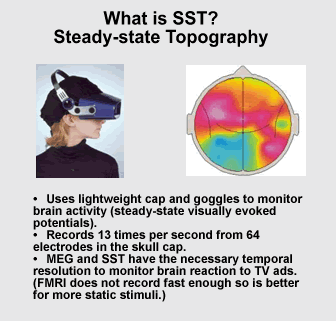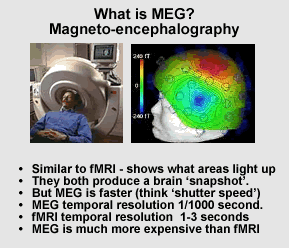![]() Receive new posting via RSS feed. >Click the icon on the left to subscribe.
Receive new posting via RSS feed. >Click the icon on the left to subscribe.
(Or right click the icon to copy and paste the link into your rss reader)
Neuromarketing: What's it all about?
From a talk of the same name delivered to the inaugural Australian Neuromarketing Symposium at Swinburne University (Melbourne) in February 2007.
By Max Sutherland
(To download a pdf copy of this with more complete text and graphics, click here.)
Brain wave recording devices have been available for decades but new technology can now pinpoint more precisely which brain regions are active as people respond to products or make brand choices or are exposed to advertisements. The neuroscience dream of being able to peer into the functioning brain has been made possible.
Rita Carter uses a wonderful analogy that brain-scan machines are opening up the territory of the mind, rather as the first ocean-going ships once opened up the globe.1 However, she cautions that our exploration and the vision of the brain that we now have, is probably no more complete or accurate than a sixteenth century map of the world.
Remember, it took a long time after Columbus discovered the American continent to explore and map the detailed topography. Someday we may have something analogous to a ‘Google Earth’ for the brain but there is a long way to go yet in understanding and mapping the detail of structures like the amygdala, the prefrontal cortex etc and their functions.2 This is a valuable perspective to keep in mind as we examine what neuromarketing is all about.
Beginnings
Neuromarketing is an applied extension of neuroscience. The application of brain-scan technology to marketing, especially the use of fMRI (see inset), gave rise to the term.

Ale Smidsts (Erasmus University) is said to have coined the term in 2002 and the first marketer to use fMRI is said to have been Gerry Zaltman at Harvard (around 1999).3
However, to me the notion of neuromarketing has been around for 30 years, even if the word hasn’t.
Peering Inside Heads.
Neuromarketing is an extension of peering inside people’s heads with devices. In the late 1960’s we were playing with pupilometers – devices that measure spontaneous pupil dilation as an indicator of peoples’ interest while they were looking at packages or print advertisements. Herbert Krugman was a pioneer.4
At the same time in marketing we were playing with GSR (galvanic skin response) as a possible indicator of people’s emotional response to advertisements. Later, we engaged with new technology for eye tracking to reveal exactly where on the page (or a TV scene) people’s eyes were actually looking. And in the 1970’s Herbert Krugman5 and Flemming Hansen6 began to explore left and right brain processes using electroencephalograph (EEG) brain wave technology.
Each of these technologies was heralded at the time as a breakthrough. But none of them found widespread, lasting use in marketing - although some, like eye tracking, carved out a small niche.
First encounters
My first encounter with these technologies was at Coca-Cola in the late 1960’s when we played around with the pupilometer to see what it could tell us about differences in interest and attention to alternative advertising executions. (The answer, we concluded, was ‘not much that you couldn’t obtain by verbal report anyway’.)
Then in 1981, I came across brain wave monitoring using SST (Steady State Topography). Professor Richard Silberstein at Swinburne University7 was using SST in pure and clinical applications and was investigating its possible use in marketing. I was impressed, even though the technology clearly had a long way to go. Today, 25 years later, I am convinced SST can provide revealing insights in marketing with the benefit of a quarter century of accumulated experience in interpreting SST brain wave activity.

The Newer Technologies
The newer technologies, fMRI and MEG (magneto-encephalography) are the latest developments in gee whiz brain-scan technologies. Their potential to impress clients has made it attractive to transition their use across into marketing. But while their potential is undoubtedly exciting, published studies deploying them in marketing remain quite scarce. Probably no more than two dozen studies have been reported in the press and barely a handful of these have published any real details in peer reviewed journals.
Early Examples:
One of the earliest studies using the newer technology was by Ambler and his colleagues at the London Business School.8 It asked people while they were in a MEG scanner (see inset) which of 3 brands they would purchase and found that familiar brands stimulate the right parietal cortex. The authors pointed to this area as the possible ‘location of brand equity’.

In 2000, Rossiter et al used SST to monitor brain waves while people watched TV ads and they were able to predict what scenes people would recognize a week later.9 They found they could predict this from activity in the left brain at the time of exposure (in the C3-F7 site of the posterior region of the frontal cortex). Until then it was thought that the crucial processing for pictures would be in the right hemisphere.
Further examples, of recent studies are in the inset panel. (For more, click here .)

Interpretation
It is one thing to see which parts of the brain become active in response to a stimulus. It is another to interpret what this means or what you can do with it. This is tackled usually by correlation with dependent variables. Rossiter et al used verbal report in the form of a scene-recognition test one week later. Ambler et al focused on differences in brain response stimulated by brands that people said they would purchase (compared to ones that they would not).
Various studies have used:
- Verbal report (e.g. scene recognition, brand preference)
- Behavior e.g. purchase vs non purchase (Ambler, Knutson)
- Different segment reactions (e.g. Democrats vs Republican brains are said to react differently to political advertisements)
But mostly the focus has been on correlation with so called ‘known centers’ such as: reward centre, self referencing centre, face recognition centre, liking centre, anticipation centre etc.
As a result, neuromarketing studies have increasingly pointed to various ‘known centers’ in the brain. Yet knowledge about these so called ‘known centers’ is often sketchy and the claims about their function are often reasoned speculation rather than known fact.
Take, as an example, a study by Knutson et al published in late 2007.10 It pointed to the insula as an area that registers price-pain. People given $20 to spend were shown products in a scanner that they could choose to buy. One part of the brain was activated when they saw brands they liked but then the higher the brand’s price, the more it triggered activity in another part of their brain, the insula. The study concluded that this is a center that registers price-pain. Within weeks however, a broader neuroscience study discovered that addicted smokers who suffered damage to this area (from car accidents etc) were suddenly able to give up their long standing addiction to smoking.11 It emerged that this part of the brain, the insula relates somehow to our ability to exercise control over addictive behaviors. Now, just how price-pain and addiction might be related, if at all, awaits further research. The message is that ‘knowledge’ about these so called ‘known centers’ is embryonic, and still developing rapidly, so this type of interpretation in terms of ‘functional centers’ needs to be taken with a good dose of caution.
It is not that long since phrenologists pointed to individual bumps on the outside of the head and made serious inferences about that person’s personality and abilities. Phrenology is of course, now totally discredited. Skeptics of neuroscience argue that it is just a form of 21st century internal phrenology. That is not my view but it is important to keep a realistic perspective as to how embryonic the field is. We really don’t know yet how to fully interpret many of these things and we are still in a very early stage.
To follow the field of neuromarketing, it is important to look at neuroscience generally and not just studies labeled neuromarketing. Studies relevant to neuromarketing appear in various neuroscience journals. If neuromarketing comes under regulatory pressure, we can expect that more of these studies will be ‘repositioned’ and re-labeled something other than ‘neuromarketing’. Neuro-aesthetics and neuroeconomics are especially relevant.
Like Drinking From a Fire-hose
The problem is that keeping up with the neuroscience literature is like trying to drink from a fire-hose. As the noted neurobiologist Steven Rose said: “The world-wide effort being poured into the neurosciences is producing an indigestible mass of facts at all levels.”
It is becoming extraordinarily difficult for full time neuroscientists to keep up - let alone businesses. Let’s face it… marketing is not interested in science or complexity. The truth is that marketing clients want ‘KIS’ not complexity. They want simplicity - an easy to understand, single number solution that says ‘this ad (or pack, or scene) ... is good/bad ….and says whether it will work or won’t work. Rather than try to drink from that fire-hose, there is a temptation for marketing to oversimplify and over-claim.
Threat
So as this bandwagon called neuromarketing picks up speed, some of the same threats that killed off previous technologies are re-emerging. A key one is over-claiming. It is an unfortunate fact that the sale of ‘smoke & mirrors’ often outsells substance. At least in the short term.
Bias towards overclaiming exists in the media as well as in the marketing of consulting services to clients. The media love sensationalist stories that can carry a headline like "'Buy centre of the brain found“. As a result, journalistic reporting is prone to outstrip the scientific substance.
Also, Joe and Jane Citizen along with the media, harbor very few doubts about the power of advertising and believe it knows what it is doing - otherwise why would it be using neuromarketing? As Ehrenberg once observed: “Advertising is in an odd position. Its extreme protagonists claim it has extraordinary powers…. and its severest critics believe them.”12 Mystique forms a convenient climate for smoke-and-mirrors merchants, to rush in and tout their consulting services brandishing these new devices.
For the substantive pioneers this is going to make things difficult because it inevitably degrades the whole field. Where the software industry has vaporware, the marketing-research industry has toutware. The difficulty for clients is in identifying genuine scientific neuromarketing in amongst a growing clutter of toutware services on offer.
A Plea.
At this point I made a plea for this first Australian conference on neuromarketing to avoid hyper-claim. We know that ‘hidden buy buttons’ are a media fantasy but some neuromarketing suppliers cannot resist the temptation to pander to the media’s need for a sensationalist headline. Myth and mystique will be difficult to dispel and will prompt regulation to constrain neuromarketing.
Hype is likely to lead to a social backlash because marketing already stands accused as a cause in social epidemics like obesity, diabetes, alcoholism and gambling. After the legacy of Big Tobacco, marketing is not cut much slack. In 2004 I wrote a column ‘Neuromarketing in Retreat’ about how clients were shying away from neuromarketing and how conferences on it were being cancelled. I said that neuromarketing was in retreat, away from the gaze of public opinion and into the closet - but not into oblivion.
Since then neuromarketing has re-emerged and conferences like this are evidence of it. So what does this mean? Has the threat disappeared?
No. To date, the regulatory environment in the USA, with a Republican president and a Republican controlled congress, has been relatively benign. Federal regulators, the FCC and FTC, have ‘looked the other way’ on a number of controversial activities including neuromarketing (and product placement13 ). However, under the scrutiny of a new Democrat controlled Congress you can expect that these regulatory bodies will soon be casting a different eye over neuromarketing. Expect a regulatory climate change in the USA that will examine more closely, what controls are necessary in the practice of neuromarketing. And when the USA sneezes the rest of the world catches cold.
Conclusion
I am an unabashed enthusiast of neuroscience for I am convinced it is opening up a whole new world of understanding of the mind. As it develops, neuroscience will deliver increasingly powerful, marketing insights.
Its immediate application to general marketing requires businesses to tread carefully and disentangle the scientific substance from the promotional hype. Businesses prepared to exercise this caution and engage with it now have an opportunity for early-mover advantage before its application of neuromarketing gets constrained by regulation.
In the longer term, neuromarketing will be far more socially welcome for applications that focus on products and causes with a clear social benefit - applications like road safety messages and persuading people to give up smoking or to resist over-eating. Developing and testing strategies that are designed to cure rather than create social pathologies is hard to argue with. Used in this type of application, neuromarketing will be refined to public applause, rather than public alarm.
Download pdf copy of "Neuromarketing: What's it all about?"
Notes
1. Carter. R. (2000). Mapping the Mind. London, Phoenix. P93-4
2. We now know with the amygdala for example that the left and the right, along with the anterior and posterior regions of the amygdala perform very different functions and the same clearly applies to many other broad structures of the brain.
3. According to Lewis & Bridger in "Advances in Clinical Neuroscience and Rehabilitation". Advocates QEEG Jul-Aug 2005
4. Krugman, H. E. (1964). "Some Applications of Pupil Measurement." Journal of Marketing Research 1(4): 15-19.
5. Krugman, H. (1977). "Memory Without Recall, Exposure Without Perception." Journal of Advertising Research (August 1977).
6. Hansen, F. (1981). "Hemispheral Lateralization: Implications for Understanding Consumer Behavior." Journal of Consumer Research 8(1): 23-36.
7. Then Swinburne Technical College, Melbourne Australia.
8. Ambler, T., J. Stins, et al. (2002). "Salience and Choice: Neural correlates of shopping decisions." London Business School, Centre for Marketing Working Papers No. 01-902.
9. Rossiter, J. R., R. B. Silberstein, et al. (2001). "Brain-imaging Detection of Visual Scene Encoding in Long-term Memory for TV Commercials." Journal of Advertising Research: 13-21.
10. Knutson, B. et al. Neural predictors of purchases. Neuron 53, 147–156 (2007)
11. Naqvi (2007). "Damage to the Insula Disrupts Addiction to Cigarette Smoking" Science 315(5811): 531 - 534.
12. Ehrenberg, A. (1982). "Repetitive advertising and the consumer." Journal of Advertising Research 1: 70-79.
13. Sutherland, M. (2006). "Comments on Product Placement." International Journal of Advertising 25(1): 107-114.


